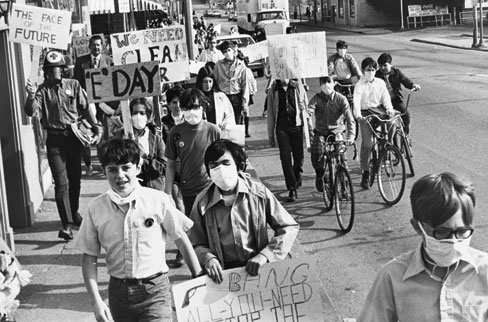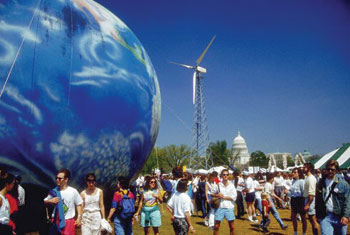 Spring 2009
Spring 2009|
Earth Day
 Students in St. Louis march against air pollution in 1970. Below, decades later, crowds gather at an Earth Day celebration on the lawn of the Capitol in Washington, D.C.
The impetus to stage an Earth Day began building in the 1960s. In 1962, Pittsburgher Rachel Carson’s best-selling book Silent Spring alerted the public to the hazards of pesticide use. Soon after, scientists pronounced the Great Lakes “dying” due to agricultural and industrial runoff. In 1969, a large oil spill off Santa Barbara, California, fouled formerly pristine shoreline. Later that year, Cleveland’s heavily polluted Cuyahoga River caught fire. The image captured the extreme degradation humans had brought on their environment. “People really began to think, good heavens, do we really have to live like this?” remembers Patricia DeMarco, the executive director of the Rachel Carson Homestead Association in Springdale. “Is the Earth really meant to be the dumping grounds of human activity?” U.S. Senator Gaylord Nelson, of Wisconsin, was among those who saw a need for change. Nelson was fed up with inaction by his Senate colleagues on environmental issues, so he prevailed upon a young aide, Denis Hayes, to organize a nationwide teach-in on the subject. Across the country, 20 million people attended speeches, parades, and rallies. Folk singer Pete Seeger played at the Washington Monument. Traffic on New York City’s Fifth Avenue was closed. Congress took the day off for members to attend events in their home districts. Mother Nature even cooperated—the weather that day was spectacular. DeMarco was in Pittsburgh on the first Earth Day, taking part in protests and teach-ins around the University of Pittsburgh. She was among a group of students who sat on Forbes Avenue to protest environmental degradation. “We backed up all the street cars on Forbes and Fifth Avenues,” DeMarco recalls. So, what difference can a day make? A lot. This particular one gave environmentalists like Donald Gibbon the feeling they weren’t alone. “Rather than being marginalized as kooks and radicals, there was an opportunity all of a sudden for everyone to come out of the closet and show their support for the environment,” says Gibbon, who is program and environmental education chair for the Sierra Club’s Allegheny Group. The event highlighted the size and vigor of the nascent environmental movement. At the time, the Environmental Protection Agency (EPA) had not yet been formed; there was no Clean Air or Clean Water Act; federal environmental regulation was nonexistent for many pollutants. All those things were about to change. The federal government formed the EPA later that year, and one of the agency’s first actions was to ban DDT, the pesticide whose deadly effects on wildlife, particularly birds, was detailed in Carson’s Silent Spring. The Endangered Species Act and other landmark laws soon followed. And Earth Day deserves a lot of the credit for those developments, says Bernard D. Goldstein, a professor of environmental and public health at the University of Pittsburgh. “It demonstrated to policymakers that the public really cared about the environment. In this country, nothing happens if the public doesn’t support it.” Today, Earth Day’s impact can be seen everywhere. Most U.S. cities recycle; environmental April 22, Earth Day, is now celebrated around the world by hundreds of millions of people who commemorate the event by taking part in cleanups, environmental film festivals, even eco-friendly cocktail parties. But at its core, Earth Day’s simple message remains unchanged: There’s only one Earth. Better take care of it. |
Carnegie Museums After Dark · Art Without Walls · Recollecting Andrey Avinoff · Look… to see, to remember, to enjoy · President's Note · NewsWorthy · Now Showing · Face Time: Kim Amey · About Town: Art in Bloom · Field Trip: Year of Restoration · Science & Nature: Scientists Among Us · Artistic License: Bosom Buddies · Another Look: 13 Most Beautiful…
 |
Copyright © 2017 CARNEGIE Magazine. All rights reserved. |

 Sometimes, one day can make all the difference. Consider the first Earth Day, April 22, 1970. Protests over the Vietnam War were going full throttle. The struggles and triumph of the civil rights movement were still recent memory. But as thousands of students, activists, and organizers took to the streets that spring day, the plight of Mother Earth took center stage. More than 20 million people participated in the event, which became a kind of kickoff for the modern environmental movement.
Sometimes, one day can make all the difference. Consider the first Earth Day, April 22, 1970. Protests over the Vietnam War were going full throttle. The struggles and triumph of the civil rights movement were still recent memory. But as thousands of students, activists, and organizers took to the streets that spring day, the plight of Mother Earth took center stage. More than 20 million people participated in the event, which became a kind of kickoff for the modern environmental movement.